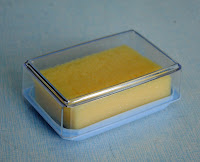Ever get a GREAT idea, only to find out you're not the first one to think of it?
I recently taught about Western art education to a group of local Chinese teachers.
A post for another time. I stressed the importance of problem-solving, critical thinking, and originality in art, not copying the teacher. There's much more to be said about this training, but I told the teachers about a Saturday morning cartoon that I will never forget. It was a little blurb from Aladdin's Genie challenging the idea that
great minds think alike. Instead, he would change the phrase to
great minds think for themselves.
So while I don't think my ideas are that unique, amazing, or original, I still pride myself in thinking for myself.
Something about American values of individualism and charting your own path that has been engrained into my person from my upbringing, including Saturday morning cartoons. Sure, I'm inspired by everything in life, but I'm less likely to copy a lesson, bulletin board, or activity exactly. And a lot of my ideas, they come from my own mind, combining various things I've seen online, in books, at another school, or completely unrelated to art education. Yet over and over I see that there is nothing new under the sun.
In my first year of teaching, my friend Miss Emily told me about her third grade painting lesson, based on the artwork of Wayne Thiebaud. I'm not sure where she got her idea, but between my first and second weeks of teaching the project, I found an almost identical lesson in a six year old copy of School Arts magazine!
Now this year, I was so excited by an idea that came to me in the middle of my first art class. Less than 24 hours later, saw it on a list of
20 Creative Bulletin Board Ideas for Art Teachers. So I guess it's not original, but it was a great
first day of art class activity.

For all my classes, except for that first group of 5th graders, I welcomed them to the art room, then passed out a piece of paper, cut hotdog-style, that had "Art is" printed on it. The students could finish the sentence any way, with as many or few words as they needed, and decorating however they saw fit with crayons, markers, and colored pencils. After they worked for a while, I let students share their sentences, followed by reading the book
Art Is... by Bob Raczka. (I turned the book into a Prezi to make it easier for the students to see the pictures.) We then went over
art class expectations and created namecards for my job pockets.
To display the work, I created a custom-border with the lines from the book.






I love their answers. One boy wanted a second piece of paper and attached his two answers.
"Art is droling (drawing).
Art is lerneing (learning)."
Of course, art is fun, fun, fun, fun, and funny.
But did you also know it's
boenqshrs?
It is also: amazing, magical, a great subject, my favorite subject, good, bad, cool, nothing, fear, difficult to me, even fun, color, drawing magic, beautiful, creative, fantastic, unusual, great, pretty, perfect, m&m...
Finally, as the book says,
"Art is how artists get you to think."
So the moral of the story: Think for yourself, realizing that someone else probably already thought of it. But it's about the process, not the product, so still do the thinking.
boenqshrs is 1st grade spelling and mirroring of letters for doing (boen) pictures (qshrs).

 I was excited to feature the Taj Mahal because it represents a different nationality in our student body (India was the country of study for our middle school students during Global Village Day) and because I just taught the structure to my AP Art History students. Lastly, it was extra cool because I rediscovered these famous landmarks cards, cut from a poster purchased this summer at my trusty standby, French Wal-mart. Less than a dollar for the poster--I love that store!
I was excited to feature the Taj Mahal because it represents a different nationality in our student body (India was the country of study for our middle school students during Global Village Day) and because I just taught the structure to my AP Art History students. Lastly, it was extra cool because I rediscovered these famous landmarks cards, cut from a poster purchased this summer at my trusty standby, French Wal-mart. Less than a dollar for the poster--I love that store!


















































